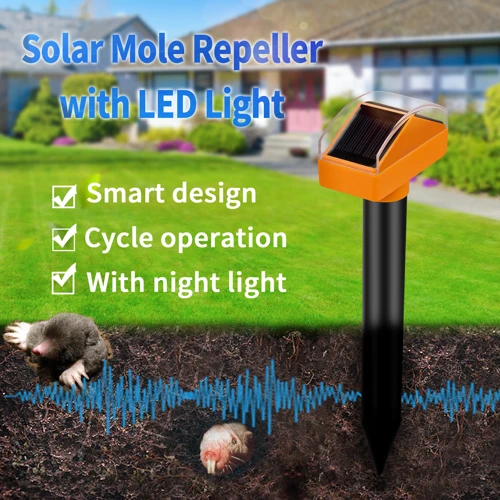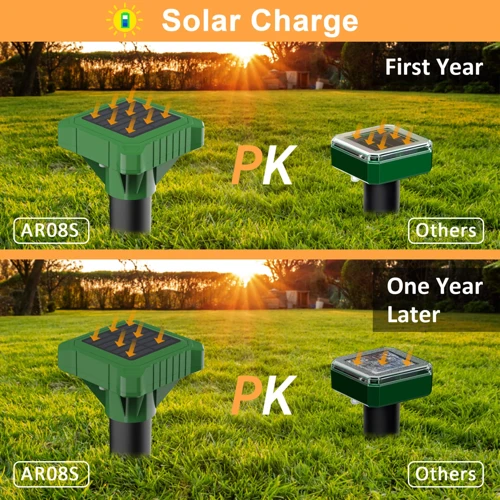Have you ever experienced the frustration of finding unsightly tunnels and holes all over your lawn, courtesy of pesky moles? Are you tired of resorting to costly and potentially harmful chemical repellents or unreliable natural remedies? Look no further than a DIY Vibrating Mole Repellent Using Solar Power. With just a few simple tools and materials, you can create a humane and effective solution that harnesses the power of the sun. Say goodbye to the damage-causing and disease-carrying creatures and hello to a beautiful lawn with this step-by-step guide.
Why Repel Moles?

As gardeners, we put a lot of effort into maintaining the beauty and health of our lawns and gardens. However, these efforts can be disrupted by the presence of moles. This is why finding ways to repel moles becomes essential. Moles can cause damage to your lawn and garden, and they also pose some health concerns, making it necessary to take action. Do you know what damage moles can cause, or why it is important to keep them away? Learn more by checking out these resources: 10 Natural Ways to Get Rid of Moles in Your Garden, Keeping Moles Away from Your Garden, Natural Deterrents for Moles in Plants, Garlic as a Mole Repellent, Marigolds as a Mole Deterrent, Aluminum Foil to Keep Moles Out of Your Garden, Planting Bulbs for a Mole-Free Garden, and Using Coffee Grounds for Mole Exclusion.
Damage to your lawn and garden
Garden and lawn damage caused by moles can be extensive and frustrating for homeowners. Moles burrow through the soil in search of worms and grubs, leaving behind unsightly mounds of dirt and tunnel systems. This can disrupt the root systems of plants and result in damage to the lawn.
The following are some examples of damage caused by moles:
- Unsightly mounds of dirt on the lawn which can make it difficult to mow the lawn.
- Plant roots can be damaged or destroyed resulting in wilting or death of the plant.
- Disturbed soil conditions can make water penetration difficult, causing irrigation problems for garden plants.
- As moles dig tunnels, they can create air pockets, causing the ground to shift and soil to become unstable.
- Their burrowing activities can also contribute to soil erosion and the development of sinkholes in extreme cases.
In addition to the physical damage, moles can also attract other predators such as snakes and rodents, which can pose a safety risk to humans and pets. It is important to take mole control measures in order to prevent these issues from occurring.
Health Concerns
Moles are not generally known to carry diseases that can be transmitted to humans, making their presence relatively harmless in that regard. However, their tunnels can become a breeding ground for other pests like rats or mice, which can be hazardous to human health. Additionally, moles can cause injuries or accidents when their tunnels weaken the structural integrity of structures like sidewalks or buildings.
Here are some health concerns associated with moles:
- Moles can attract other pests like rodents, which are known carriers of diseases that can impact human health.
- Accidents can occur if moles undermine the foundation of structures like sidewalks or buildings, leading to potential injuries.
- Moles can also cause harm to livestock or pets by creating holes that they can fall into or that can impact their ability to graze or move around safely.
- In rare cases, moles can also damage irrigation systems, leading to potential health hazards through the contamination of water supplies.
It’s important to address mole infestations not just for the sake of your lawn and garden, but also for the safety and well-being of your family and pets. By understanding the potential health concerns associated with moles, you can take proactive steps to address mole infestations on your property.
Traditional Mole Repellent methods

If you have moles in your garden or yard, you may be looking for effective ways to repel them. Fortunately, there are several traditional methods that have proven to be effective. From chemical solutions to natural remedies, there are a variety of ways to get rid of these burrowing pests. Let’s explore some of the most popular options and see how they can help you keep your lawn and garden safe.
Chemical methods
Chemical methods for repelling moles involve the use of toxic chemicals that can be harmful to both the environment and other animals. Some popular chemical mole repellents include castor oil, aluminum ammonium sulfate, and mothballs. These chemicals work by emitting an odor that is unpleasant to moles, causing them to leave the area. However, these chemicals are not foolproof and often require frequent reapplication to be effective.
Another chemical method that has been utilized is the use of poison baits. These baits contain zinc phosphide, a toxic compound that can kill moles upon ingestion. While this method can be effective, it poses a threat to other animals in the area that may accidentally ingest the bait. It is not a humane method and can cause unnecessary suffering to the mole.
There are also smoke bombs and gas cartridges available that are designed to suffocate moles in their tunnels. These methods can be effective, but they also have environmental consequences and can harm other animals that may be in the vicinity.
Chemical methods for repelling moles should be used as a last resort and with caution. They can be harmful to the environment, other animals, and even humans if not used properly. They may not be as effective in the long term compared to other methods.
Natural methods
When it comes to naturally repelling moles, there are several options to choose from. These methods are environmentally friendly and do not pose a threat to other animals or humans. Below is a table summarizing some common natural mole repellent methods, along with their effectiveness and drawbacks.
| Method | Effectiveness | Drawbacks |
|---|---|---|
| Castor Oil | Effective in the short-term, but must be reapplied often | May damage plants and can be expensive |
| Gaseous repellents (such as garlic) | Minimal effectiveness | Can be overpowering and unpleasant to smell |
| Planting repellent plants (such as daffodils or alliums) | Minimal effectiveness | May not be aesthetically pleasing and could attract other unwanted pests |
| Ultrasonic repellers | Minimal effectiveness | Can be expensive and may not work in all environments |
It’s important to note that natural methods may not be as effective as chemical methods or the DIY vibrating mole repellent. However, they are great options for those who prefer environmentally friendly solutions or are looking for a more affordable option. It’s important to consider the drawbacks of each method before deciding on a course of action.
DIY Vibrating Mole Repellent Using Solar Power

Tired of moles wreaking havoc on your lawn and garden? Traditional mole repellent methods might not always be effective, leaving you feeling helpless. But fear not, because we have a solution for you – a DIY vibrating mole repellent using solar power! With just a few tools and materials, you can create your own innovative and eco-friendly solution to keep moles at bay. Follow our step-by-step guide and you’ll be well on your way to a mole-free outdoor space.
Tools and Materials needed
To create your own DIY Vibrating Mole Repellent using solar power, you will need a few essential tools and materials. Here is a breakdown of everything that you will require:
| Tools | Materials |
| Soldering Iron | 555 Timer IC Chip |
| Wire Cutter | 1K Ohm Resistor |
| Wire Stripper | 2N3904 NPN Transistor |
| Multimeter | 9V Battery Clip |
| Drill | Small Solar Panel (5V) |
| Hot Glue Gun | Vibrating Motor (3V-6V) |
| Phillips Head Screwdriver | Small Breadboard |
| Small Pliers | Connecting Wires |
| Scissors | Electric Tape |
Some of these tools and materials may be available in your toolkit, but others may require purchasing. It’s important to have everything you need ahead of time to make the process smoother. Once you have all the necessary tools and materials, it’s time to get started with the step-by-step process.
Step-by-Step Guide
Step-by-Step Guide:
- Gather Materials: Gather all the necessary materials. You will need a solar light, vibrating motor, some aluminum sheets, and glue.
- Assemble the Solar Light: Assemble the solar light according to the manufacturer’s instructions.
- Prepare the Aluminum Sheets: Cut the aluminum sheets according to the length and width needed for the project. The sheets will be used as the base and cover for the vibrating motor.
- Attach the Vibrating Motor: Cut a hole in the aluminum base sheet to fit the vibrating motor. Attach the motor to the sheet using glue.
- Cover the Motor: Cover the vibrating motor with the aluminum cover sheet and glue to the base sheet. Make sure that the motor is properly sealed by applying glue on the corners and edges of the sheet.
- Attach the Solar Light: Attach the solar light to the top of the aluminum sheet covering the vibrating motor. Secure it with glue, and ensure that it is placed in a position where it can receive maximum sunlight.
- Test the System: Place the device in the sun and wait for the solar light to power the motor. Once it starts vibrating, test its effectiveness by burying it in the ground where you’ve spotted mole activity. Make sure you place the device at a depth where the moles are active, and keep monitoring the area to see if it deters the moles.
By following these simple steps, you can create an effective mole repellent that uses solar power to keep the pests away from your lawn and garden.
How it Works

The DIY vibrating mole repellent works by emitting sound waves and vibrations into the ground, which cause moles to feel uncomfortable and leave the area. The device is powered by solar panels, which collect energy from the sun during the day and store it in rechargeable batteries, allowing the repellent to work at night.
Sound Waves: Sound waves are a type of energy that travels in wave-like patterns. The DIY mole repellent emits sound waves at a frequency of around 400 Hz, which is high enough to be uncomfortable for moles but still within the range of human hearing. These sound waves are broadcast through a speaker that is placed inside a durable, waterproof housing.
Vibrations: The device also creates vibrations by using a small motor to shake a weighted plate inside the housing. This mimics the vibrations caused by burrowing rodents, which can signal to moles that predators are in the area.
Solar Power: The solar panels on the top of the housing collect energy from the sun during the day and store it in batteries housed within. The energy gathered is then used to power the vibrating motor and the speaker, which both work together to repel moles.
Mole Behavior: Moles are creatures that rely heavily on their sense of touch and sound to navigate underground. When the DIY mole repellent emits vibrations and sound waves, it interrupts their ability to navigate and communicate with one another, causing them to feel uncomfortable and stressed. As a result, they will leave the area in search of a more hospitable environment.
The DIY vibrating mole repellent creates a constant disturbance in the soil, causing moles to feel uncomfortable and seek out calmer, quieter environments. With the use of solar power, this repellent is both eco-friendly and low maintenance, making it the perfect solution for those looking for an effective, long-term mole control solution.
Advantages of a DIY Vibrating Mole Repellent

One of the most significant advantages of a DIY vibrating mole repellent using solar power is that it’s an eco-friendly alternative to the traditional mole repellent solutions. Unlike chemicals, it doesn’t pose any risks to the environment, animals, or humans. This repellent is powered by solar energy, which is a renewable resource, which means that there are no additional energy costs required to operate this device.
Another advantage of this type of repellent is that it’s relatively easy and inexpensive to build, making it accessible to everyone. The materials needed to build the repellent are also readily available at most hardware stores. Since it’s a DIY project, you have the freedom to customize it to your preferences and needs.
The vibrating method used in this repellent is another advantage. Unlike other mole repellent methods that may lose their effectiveness over time, the vibrations produced by this device are a continuous and long-term solution. This means that you won’t have to keep replacing the repellent or continuously apply chemicals to your lawn or garden.
Vibrating mole repellents are more humane than traditional methods. It doesn’t involve killing or harming the moles or their habitats. It simply creates an environment that the moles will find uncomfortable and eventually leave. This method also has no negative impact on other beneficial animals, such as earthworms, which play an essential role in maintaining a healthy lawn or garden.
Finally, a significant advantage of a DIY vibrating mole repellent is its low-maintenance requirements. Since it’s powered by solar energy, there are no batteries to replace, no wires to run, and no electricity bills to pay. As long as it’s placed in an area where its solar panel can receive enough sunlight, it can be left to work without any additional intervention.
Building a DIY vibrating mole repellent using solar power has numerous advantages, making it a wise and effective investment for any lawn or garden owner.
Limitations and Considerations
It’s important to consider the limitations and potential challenges that may arise when using a DIY vibrating mole repellent using solar power.
Effectiveness: It’s worth noting that the efficacy of the vibrating mole repellent may vary depending on the type of mole in your lawn, as well as the size and layout of your lawn. While this method has worked for many people, its effectiveness may not be guaranteed for everyone.
Weather Conditions: The success of a solar-powered device is heavily reliant on favorable weather conditions. In areas where there is limited sunlight or consistent cloud cover, the device may not work effectively. Additionally, in severe weather conditions like heavy rain or snow, the device may malfunction or become damaged.
Positioning: It’s important to take careful consideration in where the device is positioned in your lawn. For the vibrating mole repellent to be effective, it needs to be installed directly into the ground. This requires locating an area that is free from rocks or other obstructions that may prevent installation.
Maintenance: While a DIY vibrating mole repellent requires very little maintenance, periodic checks will need to be performed to ensure that the device is still functional. Batteries may need to be replaced, and the solar panel may need to be cleaned periodically to ensure that it is working at maximum efficiency.
A DIY vibrating mole repellent using solar power is an effective, natural, and eco-friendly method for repelling moles. However, it’s important to consider factors like effectiveness, weather conditions, positioning, and maintenance when choosing to install this device in your lawn.
Conclusion
In conclusion, creating your own DIY vibrating mole repellent using solar power is a cost-effective and environmentally friendly approach to keeping your lawn and garden free from mole damage. By utilizing simple tools and materials, you can easily create a functional mole repellent that not only helps you avoid the use of harsh chemicals but also utilizes renewable energy sources to power itself.
While there are traditional mole repellent methods available, such as the use of chemicals or natural deterrents, these methods can pose risks to your health and the environment. Chemicals may also harm other animals and plants in your garden, while natural deterrents may not be as effective in repelling moles.
However, by using a vibrating mole repellent, you can ensure that moles are driven away without causing harm to the environment or other animals. This method works by emitting vibrations underground that mimic natural disturbances caused by predators, causing moles to relocate to a safer location.
Another advantage of a DIY vibrating mole repellent is that it can be customized to fit your specific needs. You can adjust the frequency and strength of the vibrations to best suit the size of your garden or lawn, ensuring that moles are effectively repelled.
However, it is important to note that while a DIY vibrating mole repellent can be effective, it may not be the best option for all situations. In areas with heavy mole infestations, it may be more effective to combine this method with other traditional mole repellent methods. It is also important to regularly maintain the device to ensure that it continues to function properly.
Ultimately, creating your own DIY vibrating mole repellent using solar power is a great way to repel moles without harmful chemicals and utilizing renewable energy sources. With the right tools and materials, you can successfully create an effective and eco-friendly mole repellent for your lawn and garden.
Frequently Asked Questions
What is a mole repellent?
A mole repellent is a device or substance that is used to discourage moles from digging or tunneling in a specific area, such as a garden or lawn.
Do moles cause harm to plants?
Yes, moles can cause serious harm to plants by uprooting them and creating unsightly mounds of dirt on lawns and gardens.
Are traditional mole repellent methods effective?
Traditional mole repellent methods, whether chemical or natural, are not always effective since moles can adapt and become immune to certain substances over time.
Why use a DIY vibrating mole repellent using solar power?
A DIY vibrating mole repellent using solar power offers a cost-effective and environmentally friendly solution to the problem of moles in your lawn or garden.
What materials are needed to make a DIY vibrating mole repellent?
You will need a solar panel, a battery, a DC motor, PVC piping, and a switch to make a DIY vibrating mole repellent.
How long does it take to make a DIY vibration mole repellent?
The process can take anywhere from 30 minutes to an hour depending on your experience and skill level.
How does a DIY vibrating mole repellent work?
A vibrating mole repellent emits a vibration through the ground that moles perceive as a sign of danger, causing them to avoid the area.
Are there any advantages to using a DIY vibrating mole repellent?
Yes, DIY vibrating mole repellents are cheaper than professional pest control services and have no negative environmental impact.
Are there any limitations to using a DIY vibrating mole repellent?
DIY vibrating mole repellents may not work as well in heavily wooded or rocky areas or in locations with a high concentration of moles.
Is it necessary to use a mole repellent if I don’t have a mole problem?
No, it is not necessary to use a mole repellent if you don’t have a mole problem. Prevention, such as removing their food sources, is the best way to reduce the likelihood of a mole infestation.







